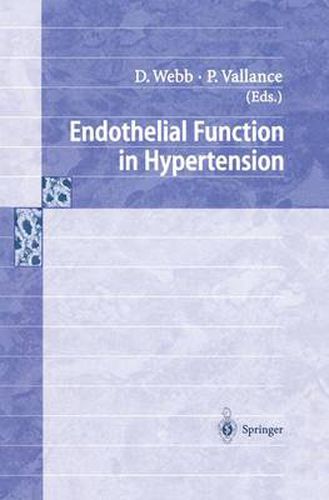Readings Newsletter
Become a Readings Member to make your shopping experience even easier.
Sign in or sign up for free!
You’re not far away from qualifying for FREE standard shipping within Australia
You’ve qualified for FREE standard shipping within Australia
The cart is loading…






This title is printed to order. This book may have been self-published. If so, we cannot guarantee the quality of the content. In the main most books will have gone through the editing process however some may not. We therefore suggest that you be aware of this before ordering this book. If in doubt check either the author or publisher’s details as we are unable to accept any returns unless they are faulty. Please contact us if you have any questions.
In 1980, Furchgott and Zawadzki demonstrated that the ability of a blood vessel to relax to acetylcholine is entirely dependent upon the presence of an intact endothelium b1. This startlingly simple and elegant observation heralded a decade of basic research into endothelium-derived vasoactive factors (EDRF). Initially, interest focused on Furchgott’s endothelium-derived relaxing factor, which was later identified as the extremely simple molecule, nitric oxide [21. However, bioassay systems suggested the presence of other dilator and constrictor factors. Many of these additional putative factors remain elusive but one constrictor factor was revealed to the world in an impres- sively complete piece of science published in 1988. Yanagisawa, Masaki and colleagues [31 demonstrated the synthesis of a twenty one amino acid peptide which accounted for the constrictor activity found in the supernatant of endothelial cells. They identi- fied its structure, synthesised the peptide, showed its biological activity in vitro and in vivo, proposed mechanisms of action and cloned and sequenced the gene. They named the factor endothelin. The identification of nitric oxide and endothelin has also rekindled interest in established endothelium-derived mediators, including the prostanoids and other arachidonic acid metabolites, and has led to exploration of the possible roles of oxygen radicals such as superoxide. The vascular endothelium has become a major focus for research into disease states or cardiovascular risk factors associated with abnormal vascular tone or reactivity, alterations in cellular adhesion to the vessel wall, increased smooth muscle cell growth and the chronic process of atherogenesis.
$9.00 standard shipping within Australia
FREE standard shipping within Australia for orders over $100.00
Express & International shipping calculated at checkout
This title is printed to order. This book may have been self-published. If so, we cannot guarantee the quality of the content. In the main most books will have gone through the editing process however some may not. We therefore suggest that you be aware of this before ordering this book. If in doubt check either the author or publisher’s details as we are unable to accept any returns unless they are faulty. Please contact us if you have any questions.
In 1980, Furchgott and Zawadzki demonstrated that the ability of a blood vessel to relax to acetylcholine is entirely dependent upon the presence of an intact endothelium b1. This startlingly simple and elegant observation heralded a decade of basic research into endothelium-derived vasoactive factors (EDRF). Initially, interest focused on Furchgott’s endothelium-derived relaxing factor, which was later identified as the extremely simple molecule, nitric oxide [21. However, bioassay systems suggested the presence of other dilator and constrictor factors. Many of these additional putative factors remain elusive but one constrictor factor was revealed to the world in an impres- sively complete piece of science published in 1988. Yanagisawa, Masaki and colleagues [31 demonstrated the synthesis of a twenty one amino acid peptide which accounted for the constrictor activity found in the supernatant of endothelial cells. They identi- fied its structure, synthesised the peptide, showed its biological activity in vitro and in vivo, proposed mechanisms of action and cloned and sequenced the gene. They named the factor endothelin. The identification of nitric oxide and endothelin has also rekindled interest in established endothelium-derived mediators, including the prostanoids and other arachidonic acid metabolites, and has led to exploration of the possible roles of oxygen radicals such as superoxide. The vascular endothelium has become a major focus for research into disease states or cardiovascular risk factors associated with abnormal vascular tone or reactivity, alterations in cellular adhesion to the vessel wall, increased smooth muscle cell growth and the chronic process of atherogenesis.